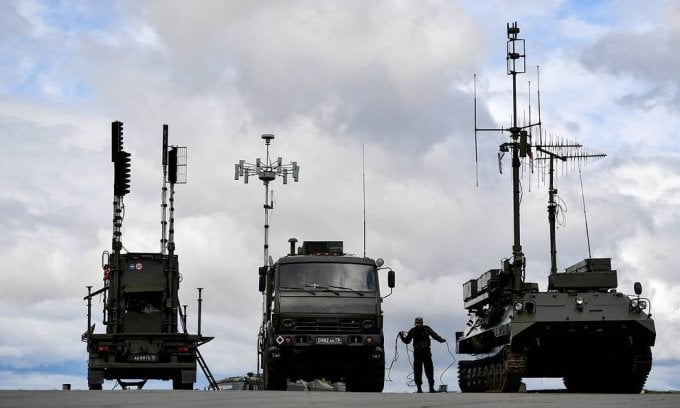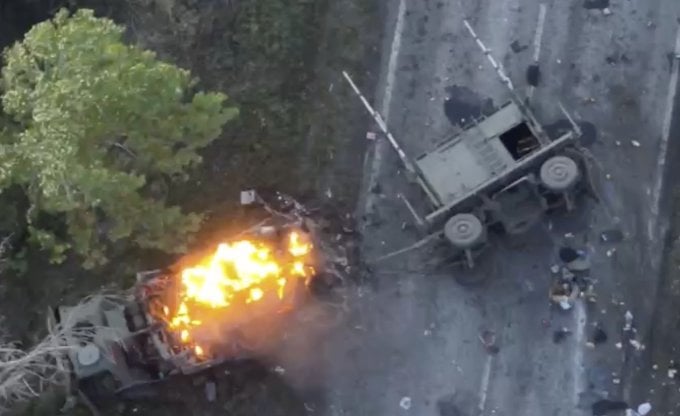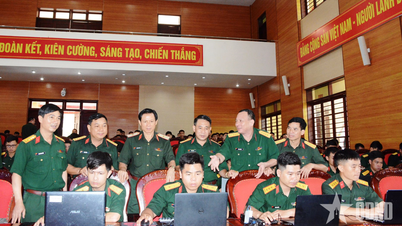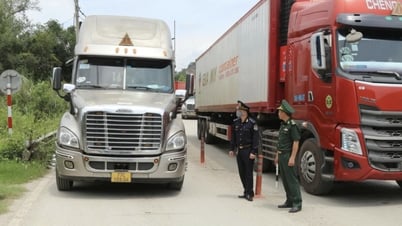The encounters and mutual restraint on the electronic warfare front between Russia and Ukraine are no less fierce than artillery and rockets.
At a reconnaissance post on the front lines in eastern Ukraine, a soldier with the alias Alain, a member of a Ukrainian electronic intelligence team, decided to change positions. He believed that the Russian military might have spotted the team's antenna and was approaching their position.
For soldiers on electronic intelligence missions like Alain, being “invisible” to the enemy is a prerequisite. Alain’s team’s work includes detecting electronic signals from Russian equipment, such as unmanned aerial vehicles (UAVs), air defense systems, jammers, artillery and rocket launchers.
Alain's team will find the source of the signal from the above equipment, then transfer the coordinates to the units tasked with destroying the target. The information collected also helps commanders have an overview of the battlefield situation.
Colonel Ivan Pavlenko, commander of the Directorate of Cyber and Electronic Warfare of the Ukrainian General Staff, said the conflict was now like a "technological confrontation".
"If I see many transmitters at the same point, I will know it is a command post. If the transmitters move, it will be a sign that the enemy is preparing to attack or counterattack," he added.

Transceiver and jammer of Russia's Pole-21 system (left). Photo: TASS
Not mentioned as much in the media as explosions or artillery strikes, electronic warfare plays an important role in the "deployment" of troops between the parties. The tug-of-war in the field of electronic warfare takes place on the almost invisible front, but is no less fierce.
Almost every modern weapon, from artillery to precision missiles, uses radio waves, microwaves or infrared signals to collect data. These modern features sometimes make them vulnerable to jamming systems.
“If you fail in electronic warfare, your army will become obsolete and be left behind by your opponents,” said Yaroslav Kalinin, director of Infozahyst, a company that produces electronic warfare systems for the Ukrainian army.
Colonel Pavlenko said that at the time Russia launched the war in Ukraine, the country's electronic warfare force had 18,000 troops, but their combat effectiveness was not as initially predicted.
"Russia at that time tried to destroy our radars to penetrate the air defense system. They partially succeeded in this goal, but did not completely defeat our air defense forces," he said.
Ukrainian air defense missile systems are still capable of shooting down Russian fighter jets, preventing Moscow from gaining control of the skies, a key factor in their failure in the campaign to control Kiev.
Russian electronic warfare forces were also unable to disable Ukraine’s communications systems, allowing the country’s military to mount an effective defense. Ukrainians were still able to use their cell phones to inform the military of Russian troop movements.
Bryan Clark, a researcher at the Hudson Institute in the US, said that the biggest problem for Russia in the early stages of the war was that electronic warfare units could not keep up with the advance of infantry and armored vehicles.
"Russian electronic warfare systems are mainly designed for defense, so they are not flexible, do not have the ability to maneuver quickly and are not numerous," he said.
But as the war dragged on, Russia learned its lesson. Instead of using bulky, easily detectable electronic warfare equipment, it increasingly deployed smaller, more mobile, and stealthy devices.
Clark said Russia has deployed hundreds of mobile electronic warfare assets on the front lines to stop Ukraine’s counterattack. These include GPS jammers, radar suppression systems and systems that prevent US reconnaissance aircraft from gathering targeting information for Ukraine’s attacks.
Mobile, agile weapons such as Zhitel and Pole-21 are effective in countering GPS and satellite communications. They can neutralize artillery-guided UAVs, as well as suicide drones targeting Russian troops.
Many of the sophisticated weapons the West is sending to Ukraine are also vulnerable to jamming, as they all use GPS signals for guidance.
"The Zhitel complex can jam GPS signals within a radius of 30 km. Weapons such as US-made JDAM guided bombs will lose direction and miss their target, because they use GPS for orientation," Clark said.
In a report by the Royal United Services Institute (RUSI), expert Thomas Withington said that the Russian jamming system cannot neutralize JDAM bombs, but will affect the accuracy, which is the feature that makes this weapon powerful.
Russian jamming equipment is also the reason Ukraine is now reluctant to use the HIMARS rocket artillery, which has played a major role in previous counterattacks. HIMARS rockets also use GPS signals for guidance and are vulnerable to Russian electronic warfare.

The destroyed Russian R-330Zh Zhitel electronic warfare system in this photo released by the Ukrainian military in September 2022. Photo: Ukrainian Army
In March, the Russian Defense Ministry claimed that the Pole-21 electronic warfare system had disabled the GPS signal of the Tu-141 UAV, causing it to crash before reaching its target. In April, an unnamed US Defense Department official confirmed that many JDAM guided bombs had failed to hit their targets due to jamming.
Colonel Pavlenko does not deny that the Russian system has reduced the effectiveness and accuracy of the weapons Ukraine receives from the West. He believes that this makes attacking Moscow's electronic warfare systems all the more important.
But Russian jamming hardware has its limitations. Some RUSI experts say that systems like Zhitel can reveal their location when they broadcast jamming signals. In addition, their powerful jamming signals can also disrupt the radio communications and radar systems of Russian soldiers themselves.
To deal with the "invisible killers" on the electronic warfare front, both Russia and Ukraine have developed measures to counter the enemy's jamming systems, including reprogramming weapons so that they can overcome jamming defenses.
"Before firing precision-guided weapons, we must have intelligence about whether the enemy has an electronic suppression system in that area. If there is a jamming signal in that area, we must find the source and destroy it, only then can we use guided weapons," Pavlenko said.
At that time, the responsibility of reconnaissance was placed on the shoulders of intelligence units such as Alain's team. Gathering at the new location, Alain announced that he had penetrated the Russian military's communication lines and was eavesdropping on the conversations of the enemy artillery force.
Alain's team's next job was to determine the coordinates of the Russian soldiers. "In war, any piece of information can be important," he said.
Mr. Hoang (According to BBC )
Source link












































































































Comment (0)